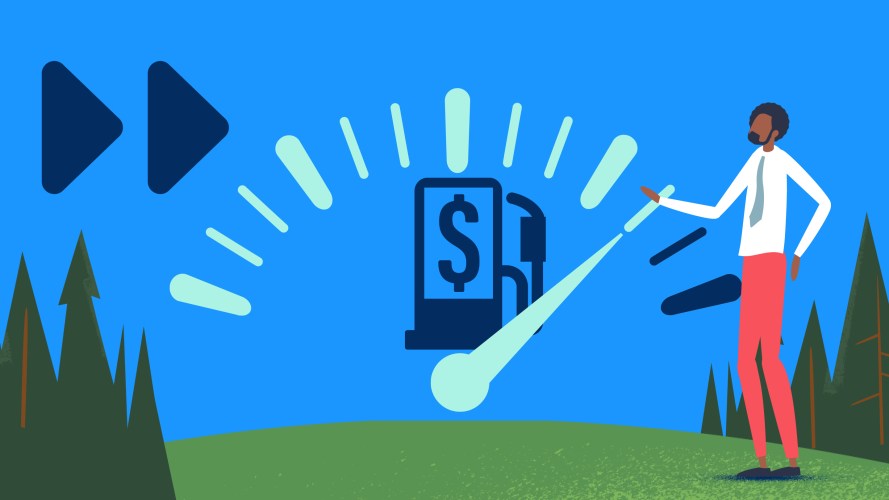It’s easy to get caught up in what to charge. But how you charge for your products and services is just as important. With usage-based pricing, you actually do get exactly what you pay for. How do you know if it’s the right business model for your company?
Let’s explore how and why companies turn to this model.
What you’ll learn:
- What is usage-based pricing?
- Pros and cons of usage-based pricing
- Examples of usage-based pricing
- How to know if usage-based pricing is right for your business
- Overcoming challenges with usage-based pricing
- Usage-based pricing technology features to look for
Unify sales, finance, and legal on the #1 AI CRM
When sales, finance, and legal are disconnected, the customer feels the pain. Learn how Revenue Cloud can help.



What is usage-based pricing?
Usage-based pricing, also called pay-per-use or a consumption model, means that a customer only pays for the products or services they use. While this model was invented for ride-sharing, telecommunications, and energy industries, usage-based pricing is now common in almost every vertical.
For example, the electric company charges customers for the amount of energy they use each month. However, the cost can fluctuate widely from month to month. A homeowner may pay a high bill in August when running the air conditioning nonstop, but a much lower bill in September when they turn off the AC and open the windows.
Companies can select from different types of usage-based pricing. Here are two common models:
- Pay as you go: With this model, customers pay for what they actually use. For example, a data storage company may charge for the actual amount of storage used. Some companies also measure billing in specific units, such as minutes for telecom or units of electricity.
- Overage model: The seller defines different usage levels and rates and a certain level of usage included with a per-unit price for usage over the threshold. Software as a service (SaaS) companies often use this model and charge a lower rate for higher usage over a defined threshold.
Pros and cons of usage-based pricing
Although the right pricing model for a business depends on multiple factors, including its customer base, costs, and company goals, companies often see the following benefits and challenges with usage-based pricing.
Pros
- Allows customers to try with little risk: If a customer decides it’s not for them, they’re only out the money for their actual usage. Customers are not locked into making a commitment beforehand by paying an upfront fee or even signing up for a trial that they must cancel.
- Provides usage and sales data: With this model, you can more easily track how your product is used. The detailed data allows you to see patterns more easily that can help you improve your product and sales strategies.
- Scalability for customers: If business needs change, you don’t need to get customers to sign on for a new plan or model. They simply use the amount they need that month. And if the demand slows back down, then they just start using less.
- Ability to operate on an overage model: Usage pricing makes it easy to scale as needs change. Businesses can capitalize on this need by using a fixed subscription model with a monthly allocation of X units. Customers can then pay for extra units as needed.
Cons
- Customer bill shock: With a usage-based model, customers incur variable costs and may unwittingly rack up a high bill throughout the usage period and then be surprised and unprepared for it.
- Challenging to create purchase orders: Because each bill is based on the exact usage, customers often struggle with creating a purchase order. Usage-based models may result in slower payments because a PO cannot be created until the invoice is delivered.
- Increased administration costs: Unlike subscription-based customers who pay before they use the services, usage-based customers pay after they use the services, which requires more administration.
Examples of usage-based pricing
Since usage-based pricing is based on how much you use, businesses can align their pricing with value delivered. Here are some of the common examples of industries using this model and how it might look:
- Cloud computing services: Customers are charged based on the amount of computing power, storage, and other resources they consume. This could include hours of use by virtual machines, the volume of data stored, and the amount of data transferred.
- Telecommunications: Companies will charge a user based on the amount of data they use. There might be a base rate for a fixed amount of data, with additional charges as that baseline is exceeded. This can be used for mobile data plans, as well as for internet service providers (ISPs).
- Utilities: This one might be the most familiar, as we have all experienced being billed based on the amount of electricity and water we consume. It means paying in proportion to your usage, with surge or higher-rate pricing during peak hours.
- SaaS: Here, pricing is based on the usage of particular features. This could include API calls, data storage, sent messages, or other communication activities. This allows customers to scale their costs with their actual needs.
- Transportation and mobility: Ride-sharing companies use a model in which passengers are charged based on the distance and duration of their trip. Peak hours and higher demand can increase the cost of the service, as it can with utilities.
How to know if usage-based pricing is right for your business
With a usage-based pricing model, companies can have the foundation needed to grow their stake in the market. Businesses have the opportunity to grow their sales in the market, expand how they do business, and remove barriers to sales. However, this model is not right for all businesses.
Here are three questions to help determine whether a usage-based model is the best approach:
- Does consumption of the product or service vary? The usage-based approach works best if the customer may need more one month and less another. If the needs stay relatively constant, a subscription model is likely the best choice.
- Can your company manage the administrative needs of a usage-based model? This model requires more time for provisioning usage-based products, generating actual usage data, rating/pricing the data, and billing-rated detail. Companies that do not have the resources to manage this additional complexity should likely use a subscription-based model.
- Do your costs increase the more a customer uses the products? If so, a usage-based model helps your company recover the expenses of increased usage.
- Do customers gain value from using the product more? Customers who benefit from increased usage are more likely to sign up for a usage-based model.
Overcoming challenges with usage-based pricing
When you shift to usage-based pricing, it can affect aspects of the entire business. Instead of it being a sales-led process, you need to involve stakeholders throughout the organization — sales, product, accounting, finance, and legal. The switch is usually transformative, requiring processes and technology across the organization to shift or be redesigned.
Another strategy for managing the issues with usage-based pricing is to consider a hybrid model. With this approach, the organization combines elements of usage-based and subscription-based pricing to create a structure that appeals to customers while improving revenue for the business. While there is no one right way to build a hybrid structure, the first step is discounting the usage price based on the level of the customer’s commitment. This typically translates to the greater the commitment, the bigger the discount. Hybrid pricing can use different models or usage packages, such as pooling, virtual currency, or minimum commitments.
Join the Salesblazer movement
We’re building the largest and most successful community of sales professionals, so you can learn, connect, and grow.

Usage-based pricing technology features to look for
By using configure, price, and quote (CPQ) software, you can more effectively manage a usage-based pricing model. However, not all tools handle all pricing structures effectively. Look for the following features:
AI-powered analytics
By using AI-powered analytics, companies can make more accurate estimates based on current market conditions, such as lower demand and seasonality. Salesforce Einstein gives companies the ability to use AI throughout their businesses by building custom applications to solve business issues. With estimates of costs based on their current usage pattern, customers also are less likely to be surprised by a large bill at the end of the usage period, which can increase their satisfaction.
AI also helps sellers discover new business opportunities, such as an add-on product or even something as big as the need for a new business unit. For example, an increase in support calls following a specific type of usage pattern may indicate that specialized consulting services can add value for the customer and revenue for the seller.
Real-time dashboards
Businesses can reduce customer churn and increase customer satisfaction by using dashboards to help their customers make smarter decisions. For example, if a customer can quickly review a summary or dashboard that tells them how much they’ve used and how much they owe, they can more accurately make usage decisions. With clean interfaces, data, and customized reports, customers have the information they need to feel confident and satisfied with the company.
Deal management
No deal is exactly the same — and your pricing needs to reflect that. Look for a tool that allows you to use rules that trigger changes when specific products are on a quote. You need to apply to change your pricing strategies with price field rules, conditions and actions. By using deal management, sales representatives have the flexibility to make changes that make sense for the company and the customer.
Integration across systems
Your pricing doesn’t exist in a vacuum. Your CPQ tool needs to integrate not only with your customer relationship management (CRM) software but it must allow access across your organization. Because you must be able to bill for all of the products you quote, it’s important to have all of the CRM, CPQ and billing functions on a single platform. With sales data flowing through Order Management, Billing, Finance, and Accounting everyone uses the same information, which increases efficiency and reduces errors.
Evolving your pricing structure
The pricing structure that worked last year or even last month may no longer work for your customers or the business. Companies often feel that their brand identity is tied up in their pricing structure, resulting in a reluctance to change. By understanding the benefits and challenges, companies can implement a usage-based structure that works for customers and sellers alike.
Create a subscription business in 6 steps
Read our ebook, “How to Grow Your Business with Subscriptions,” and start creating a predictable revenue stream that fuels growth.





























